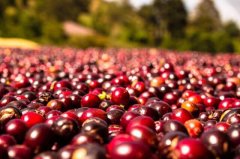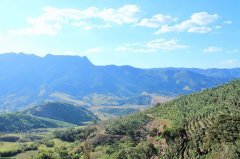Kenya Coffee grading introduction: raw Bean processing and production of Kenya AA Coffee

For professional baristas, please follow the coffee workshop (Wechat official account cafe_style)
Kenya distinguishes coffee beans by particle size, with grades of AA, AB and BB
The AA grade is approximately equivalent to screen 17 or above (the number of mesh screen is the aperture size of the screen)
AB level is about the same as screen 16.
The BB level is approximately equivalent to screen 16 or below.
Mode of production: all coffee beans are peeled, dried, fermented, washed and dried in the sun.
Raw bean treatment: coffee cherries are hand-selected and coffee farmers remove overripe or immature cherries before production. The peel and pulp were removed by 3disc Aagaarde peeling machine, and then the coffee beans were divided into three grades according to the density of coffee beans. The raw beans of grade 1 and 2 were fermented separately, while the raw beans of grade 3 were of low quality. The raw beans should be fermented in the shade for about 24 to 36 hours. After fermentation, the raw beans are washed and graded again according to the density on the cleaning channel. Then the raw beans are randomly soaked in clean water overnight.
Drying: sun-dried for 12 to 20 days, placed in an elevated bed in Africa, the drying time will be adjusted according to weather conditions, coffee beans will be covered with plastic cloth at noon and night to avoid rain.
Altitude: 900-1800 m (Kenya is a volcanic plateau)
Soil: mainly clay and volcanic red soil, clay occurs in highlands and volcanic steep slopes, generated from volcanic rocks, compared with other tropical soils, clay has better chemical and physical properties.
This is why Eva will say that Yangmingshan is the best place to grow coffee in Taiwan, because the soil high enough is not good. Coffee tree is a very land-consuming crop, it must grow in a place where the soil is fertile enough, and volcanic soil is the most suitable place for coffee growth, and the rest depends on additional fertilization, whether nitrogen, phosphorus, potassium, calcium, magnesium. For coffee trees, they are all very important!
Important Notice :
前街咖啡 FrontStreet Coffee has moved to new addredd:
FrontStreet Coffee Address: 315,Donghua East Road,GuangZhou
Tel:020 38364473
- Prev

Panama Poquet Purple Rose 40% Fine Coffee Bean Introduction
Panama Purple Rose 40% Geisha Origin: Boquet Treatment: Wash Treatment Grade: SHB Elevation: 1400-1600m Variety: 40% Geisha, Kadura Flavor: Green Apple, Cherry, Citrus, Caramel, Berry Light Flower, Honey Cream Sweet, Full, Rich, Juicy, Sweet Panamanian Coffee Originated in 1780, First Typica Introduced by European Immigrants
- Next

Brief introduction of Fazenda Alta Vista in Gaojing Manor, Brazil innovative Flavor treatment, Flavor Honey treatment of Yellow bourbon
Professional baristas please follow the coffee workshop (official Wechat account cafe_style) Fazenda Alta Vista, located in the town of Cristina in the Carmo region of southern Brazil, where Robson Vilela bought 84 hectares of land in 2001 to start his coffee business. The first time I participated in the COE competition in 2007, I won the seventh place.
Related
- Detailed explanation of Jadeite planting Land in Panamanian Jadeite Manor introduction to the grading system of Jadeite competitive bidding, Red bid, Green bid and Rose Summer
- Story of Coffee planting in Brenka region of Costa Rica Stonehenge Manor anaerobic heavy honey treatment of flavor mouth
- What's on the barrel of Blue Mountain Coffee beans?
- Can American coffee also pull flowers? How to use hot American style to pull out a good-looking pattern?
- Can you make a cold extract with coffee beans? What is the right proportion for cold-extracted coffee formula?
- Indonesian PWN Gold Mandrine Coffee Origin Features Flavor How to Chong? Mandolin coffee is American.
- A brief introduction to the flavor characteristics of Brazilian yellow bourbon coffee beans
- What is the effect of different water quality on the flavor of cold-extracted coffee? What kind of water is best for brewing coffee?
- Why do you think of Rose Summer whenever you mention Panamanian coffee?
- Introduction to the characteristics of authentic blue mountain coffee bean producing areas? What is the CIB Coffee Authority in Jamaica?

